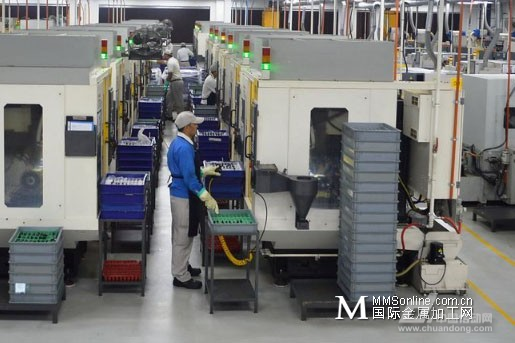In recent years, Southeast manufacturing has risen rapidly. With the transfer of a large number of factories, will Southeast Asia become the next stop for Chinese automation manufacturers?
Information technology is having a huge impact on traditional industries. The human labor production model is outdated. New generation factories adopt advanced robotic automation technology. Nowadays, it is far from enough to consider only increasing production efficiency. Market demands are changing, how to respond to the market quickly, and finding the exact demand is the right direction for the development of modern manufacturing.
The Industry 4.0 model is to build a set of information physics systems that connect production equipment, products, users, and managers through the Internet of Things technology, collect large amounts of data from the production process, use big data technology to gain insight into market demand, and give managers the best decisions. , Analyze and improve the efficiency of machine operation, guide the product from the design, production and use of the most reasonable control.
In the Internet of Everything trend, all machines are connected to the network, which means to activate the Industrial Ethernet switch market. Industrial automation products have been dominated by foreign brands and have experienced many years of development. Domestic industrial Ethernet switches have also formed some powerful companies, such as Sanwang and Dongtu. The main advantage of domestic brands lies in their cost-effectiveness. Currently, Sanwang has launched 10GbE industrial Ethernet switches and has designed dedicated products for power and rail transit. It has also developed industrial Ethernet models for a wide range of Internet of Things products.
According to Sanwang internal personnel, the competition in China's automation market has become increasingly fierce. The company is actively expanding overseas, especially in Southeast Asia. It is reported that Sanwang's sales in Southeast Asia account for about 17% of total sales, and it is expected to continue to grow in the next few years. In recent years, Southeast manufacturing has risen rapidly. With the transfer of a large number of factories, will Southeast Asia become the next stop for Chinese automation manufacturers?

Manufacturing shift to Southeast Asia For manufacturing, Southeast Asia has ample, young workforce, skilled and low-cost workers, which is the biggest attraction. The China-made Blue 2025 Blue Book stated that the global manufacturing layout has been gradually adjusted and is rapidly accelerating its migration to Southeast Asia, South Asia and Africa.
As society progresses, mankind cannot stop the rising trend in labor costs. The United States seems to be aware of the serious consequences of deindustrialization. It hopes to attract manufacturing backflows through policies, and invest heavily in automated production technologies in an attempt to use advanced production technologies to gain new competitiveness. China is also facing the trend of rising labor costs. Is the situation in the global manufacturing shift to the Southeast Asia forced?
Under the pressure of cost, some multinational manufacturing industries have shown a tendency to return to developed countries. On the other hand, global manufacturing has shifted to Southeast Asia and Africa. Last year, SAIC and GM jointly invested $700 million to build factories in Indonesia. Geely acquired Malaysia's second-largest auto brand Proton. The transfer of manufacturing means that the market has changed, and some manufacturers have begun to notice changes in these markets.
Machine substitution is an inevitable trend According to the study of the International Labour Organization, in the next two decades, more than half of the workers in Southeast Asian countries will face unemployment crisis, and the apparel industry will bear the brunt. Previously, some media reported that Nike Sportswear giants had to lay off 1,400 employees and close 25% of the production line. It is reported that there are 9 million people in Southeast Asia working in the textiles, clothing and footwear industry. Machine substitutions will have a huge impact on the industry in the short term.
More and more companies are considering using robots and 3D printing technology to produce products. Customers pay more and more attention to personalized services. In the future, the manufacturing industry must have the ability to respond quickly to market demands. Factory production must be faster and more customized in order to effectively meet customer needs.
With the rapid development of 3D printing, artificial intelligence and robotic automation technology, manufacturing is now becoming more and more advanced. In addition, the efficiency of robotic automation products is getting higher and higher, and the cost is getting cheaper and cheaper. Whether it is the United States, China or Southeast Asia, robot substitution is an inevitable trend.
Internet of Things Brings New Changes The Internet of Things has become a very hot topic in Southeast Asia. Local governments and companies are striving to research IoT technologies. According to research firm Frostand Sullivan, Southeast Asian countries invested 1.68 billion U.S. dollars in Internet of Things in 2015. By 2020, it will reach US$7.53 billion, with a compound annual growth rate of approximately 35%.
For example, Singapore regards the Internet of Things as an important foundation for a smart country. At present, a number of innovative technology fostering centers have been established to research related technologies in the Internet of Things field. The Internet of Things industry is expected to become a giant industry in Malaysia.
The Internet of Things is the foundation for intelligent manufacturing. The construction of the Internet of Things helps to realize the Industry 4.0 business model. In Southeast Asia, automation vendors will not only provide automated production facilities, but also use information technology and current control systems to build a complete supply chain network for customers. Automation will have a bright future in Southeast Asia.
Ring Type Connecting Terminals
Ring Type Connecting Terminals,Terminals,Connecting Terminals
Taixing Longyi Terminals Co.,Ltd. , https://www.longyicopperlugs.com
